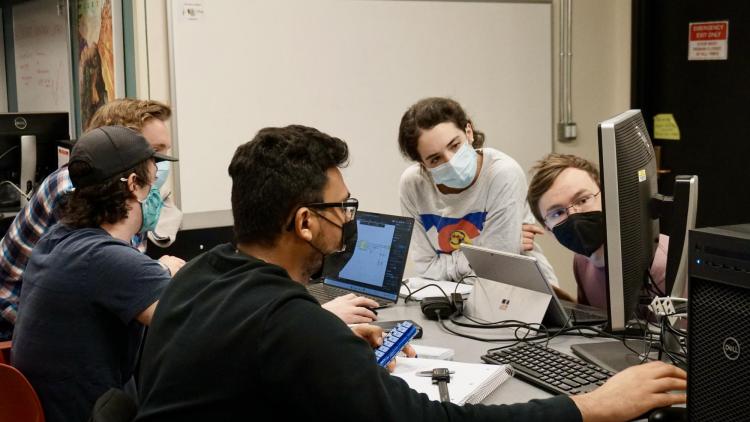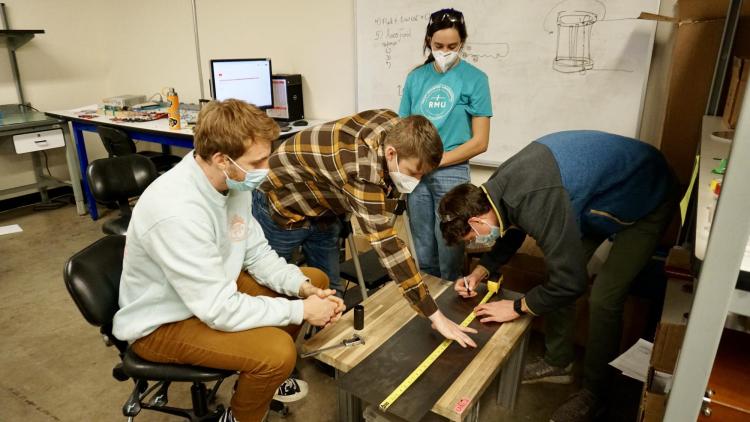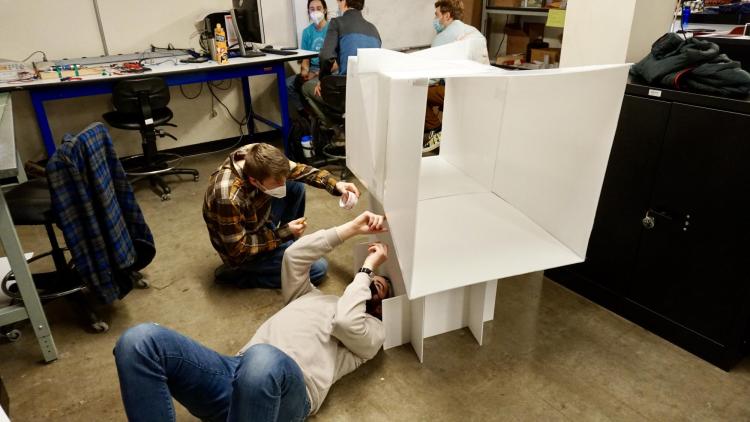Mechanical engineering students competing in national wind energy competition
A group of mechanical engineering seniors will be the first University of Colorado Boulder team to compete in the U.S. Department of Energy’s Collegiate Wind Competition (CWC) – an event in which future engineers are challenged to find a unique solution to a wind energy project.
- Aaron Schwan - Systems Engineer
- Alec Kostovny - Logistics Manager
- Anika Levy - Manufacturing Engineer
- Erik Feiereisen - Electro-mechanical Engineer
- Claire Isenhart - Project Manager
- Charles Candon - Test Engineer
- Graham Blanco - CAD Engineer
- Kiro Gerges - Electro-mechanical Engineer
- Luke Walker - Electro-mechanical Engineer
- Simon Grzebien - Financial Engineer
Header image: The 2021 team's prototype, which the 2022 team is drawing inspiration from.
CU Boulder’s Wind Team, founded in Senior Design, won its spot in the competition because of the students’ successful preliminary design and plans. The group first entered the event as a learn-along team, which meant they could participate but not be in the running for the actual competition.
For the 2022 competition, organizers decided to open one spot for a learn-along team. They recognized the CU Boulder Senior Design Wind Team’s hard work and promoted the group to the full competition, which will happen May 16-19 in San Antonio, Texas.
“When we were being graded as a learn-along team last semester, we really didn’t know if we were going to make it or not,” said Claire Isenhart, the team’s project manager. “Then we found out in January that we actually won the first phase against other learn-along teams. It will be a great opportunity for us.”
Each team is tasked with multiple projects as part of the CWC, since the multidisciplinary competition aims to prepare students for all parts of the wind industry. These projects include building an offshore wind turbine prototype, developing a site plan for a hypothetical wind farm and partnering with industry professionals and K-12 educational programs to raise awareness of wind energy in their community.
Teams competing in the CWC will be judged and receive points for each of these three individual projects. Teams with the top three highest combined scores will win first, second and third place, respectively.

Claire Isenhart getting a progress report from her team members.

Members of the team taking measurements for their design.

Students working on a a piece of their design.
The Senior Design Wind Team is already making progress. They have completed preliminary design reports for the wind farm and plan to visit a middle school in March to get young people excited about wind energy. The team’s financial engineer, Simon Grzebien, said they are making advances with their turbine prototype as well.
“We just started making our parts for the prototype in the machine shop,” Grzebien said. “We haven’t had any issues so far, but I’m sure there will be challenges that pop up. Our team feels prepared.”
Each of the students on the Senior Design Wind Team earned their place in the group. Students had to apply and interview with team director Roark Lanning to be accepted. A key piece of being offered a position was an interest in wind energy, since a core component of the competition is assessing real-world research questions surrounding the industry.
“I do want to pursue a career in the field,” Isenhart said. “I knew I wanted to work in clean energy, but I wasn’t sure how I wanted to do that until my sophomore year when I was part of the Discovery Learning Apprenticeship. I researched ways to cool wind turbine generators and methods to produce wind turbine parts. I thought that was such a cool project and I discovered I was interested in the materials.”
Her team members have similar career goals to help the world run off a cleaner source of energy. Luke Walker, one of the team’s electro-mechanical engineers, said he intends to devote his career to climate-change mitigation by using carbon-free energy technologies.
“This project provides the opportunity to study how wind energy, one of the most prolific clean-energy solutions, is accomplished from an engineering and logistical standpoint,” Walker said. “Working with wind energy is without a doubt the best way to learn about the challenges that face large-scale deployment of many forms of renewable energy.”
Erik Feiereisen, another electro-mechanical engineer on the team, added that he is interested in learning about how kinetic energy from the wind is transferred into usable electrical energy.
“It can power most everything in our lives,” Feiereisen said. “I found this project to be an interesting engineering challenge and look forward to seeing what all we can accomplish by the end of the year.”
The Senior Design Wind Team has also recruited students from outside the mechanical engineering undergraduate program to bring more perspectives to these complex projects. The team has brought on civil engineering and graduate-level mechanical engineering students to assist with their designs.
Isenhart said collaborating with these students has helped the team come up with more interdisciplinary solutions to wind energy challenges, which is what each team member will also need to do in their future careers.
In 2020-21, the first CU Boulder Senior Design Wind Team participated in the CWC as a learn-along team but did not compete in the full competition. Learn more about that team’s design and plans.

